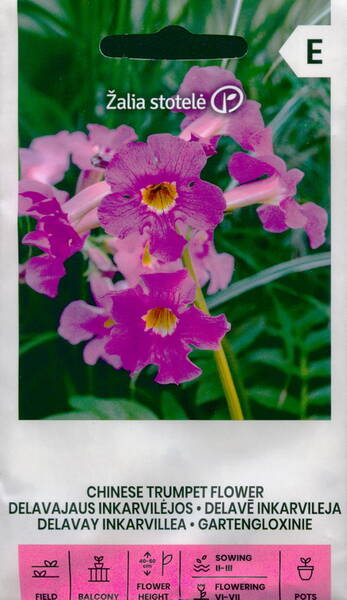Unpretentious and frost-resistant perennial.
An exceptionally beautiful plant with attractive feathery foliage. Plant height 40-60 cm.
Large pink flowers are similar to gloxinia flowers, collected in a loose, few-flowered (3-4 flowers), racemose inflorescence up to 30 cm long. Blooms from the second half of June 30-35 days.
Use in borders and for group plantings.
1.0 g = 200 seeds.
Agrotechnics.
Prefers light, fertile soils and sunny places. Requires light shelter for the winter.
Propagated by cuttings and seeds, which are sown in March in seedling boxes. Seeds are planted to a depth of 1 cm. At a soil temperature of +18+20°C shoots appear in 12-14 days. Seedlings dive. In July, they are planted in the ground, maintaining a distance of 30 cm between plants. They are shaded and watered daily. Can be sown in April-July in open ground.
Title: in memory of Pierre Nicholas D'Incarville, a French missionary who amassed a large collection of plants in China.
Homeland - Southwestern China. Perennial herbaceous plant up to 120 cm tall. The roots are fleshy, fusiform. The leaves are collected in a basal rosette, few, pinnatipartite, up to 30 cm long. The flowers are lilac-pink, up to 6 cm in diameter, with a yellow throat, collected in a loose, few-flowered (3-4 flowers), racemose inflorescence up to 30 cm long.
Blooms from the second half of June 30-35 days. Winters in the middle lane with good shelter. The fruits ripen in August - September. In culture since 1889.
An exceptionally beautiful plant, but rare in cultivation. It has a purple garden variety (var. purpurea hart.) with dark purple flowers and darker leaves.
Location: light-requiring, but tolerate some shading. It can stay in one place for up to 5 years.
Soil: thrive in light, fertile soils.
Care: winter-hardy, but only with good drainage. In snowless winters, they can freeze slightly. Annual mulching is recommended.
Reproduction: cuttings and seeds, which are sown in March in a greenhouse. Seeds are planted to a depth of 1 cm. Seedlings appear 5 days after sowing. The optimum temperature for germination is +18+20°C. Seedlings dive. In July, they are planted in the ground, deepening the root neck by 3-5 cm. Shade and water daily. It needs to be covered for the winter.
Can be sown in April-July in open ground. At a temperature of +15°C seedlings appear 12-14 days after sowing. Seedlings bloom in the second year after sowing.
In June - July they can be propagated by leaf cuttings. Incarvillea olgae is easily propagated by dividing the bush in early spring. The transplant is easily tolerated. The best period is the end of summer. Possibility of winter storage of roots in a dry substrate at +3+8°C.
Use: for group plantings along paths, on rocky areas, where they go well with iberis and violets. Look spectacular in bouquets, but do not last long.
Physical Characteristics: Perennial growing to 0.4m by 0.3m . It is hardy to zone 6. It is in flower from May to June. The flowers are hermaphrodite (have both male and female organs). We rate it 1 out of 5 for usefulness. The plant prefers light (sandy) and medium (loamy) soils and requires well-drained soil. The plant prefers neutral and basic (alkaline) soils. It can grow in semi-shade (light woodland) or no shade. It requires moist soil and can tolerate drought.
Habitats and Possible Locations: Cultivated Beds.
Cultivation details Easily grown in a deep sandy but rich soil in full sun. Plants grow better if given some shade around midday. Prefers a well-drained calcareous or neutral soil and is drought tolerant when established. Another report says that it dislikes dry summer soils. Dislikes winter wet. Prefers a sheltered position. Plants are hardy to about -15°C, tolerating even lower temperatures if the roots are well mulched, preferably with dry bracken. The crown of the plant requires protection from slugs in the winter. A very ornamental plant, it usually takes about 3 - 4 years to come into flower from seed. This species is often confused in cultivation with I. mairei. Plants are intolerant of root disturbance, it is best to place them in their permanent positions whilst small. The plants will often sulk for several years if they are divided. Propagation Seed - sow autumn or spring in a greenhouse. Prick out the seedlings into individual pots as soon as they are large enough to handle. Grow on for at least their first winter in a greenhouse and plant out into their permanent positions in spring after the last expected frosts. Division with care in early spring or autumn.
Eng.: Garden gloxinia. Suom.: Isoinkarvillea. Sven.: Rosenincarvillea.












